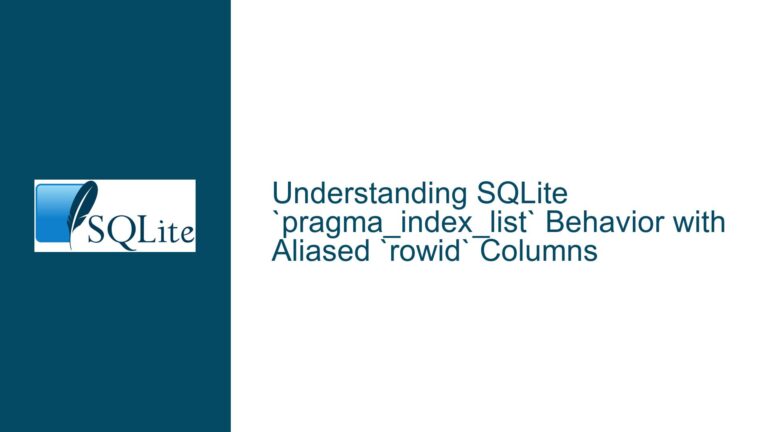FTS5 Table Aliases Cause MATCH Operator Failures in Joined Queries
Understanding FTS5 Table Alias Limitations in MATCH Queries
Issue Overview: FTS5 MATCH Operator Rejects Table Aliases in JOIN Clauses
The core problem arises when using table aliases for FTS5 virtual tables in JOIN operations combined with the MATCH operator. SQLite’s FTS5 extension allows full-text search capabilities, but its integration with standard SQL syntax has specific constraints.
When an FTS5 virtual table is aliased in a JOIN clause (e.g., t_fts AS foo_fts), the MATCH operator fails to recognize the alias as a table reference. Instead, SQLite interprets the alias as a column name, triggering a Parse error: no such column. For example:
SELECT *
FROM metadata
INNER JOIN t_fts AS foo_fts
WHERE foo_fts MATCH 'foo'; -- Error: "no such column: foo_fts"
This occurs even though the alias foo_fts is valid in other parts of the query, such as column references (e.g., foo_fts.text MATCH 'foo' works). The MATCH operator requires direct access to the original table name of the FTS5 virtual table. Attempting to reference the alias instead violates an implicit requirement of FTS5’s query parser.
The workaround of using the original table name in the MATCH clause while aliasing the table in the JOIN (e.g., WHERE t_fts MATCH 'foo') technically resolves the error but introduces ambiguity in queries with multiple joins. This approach also bypasses the alias entirely, negating its purpose.
A valid alternative is embedding the search term directly in the JOIN clause using the t_fts('search_term') syntax. This integrates the full-text search into the join condition, avoiding the alias ambiguity:
SELECT *
FROM metadata
INNER JOIN t_fts('foo') AS foo_fts ON metadata.id = foo_fts.id;
However, this method limits flexibility in constructing dynamic queries and complicates scenarios where additional filtering on the FTS5 table is required.
Possible Causes: FTS5 Parser Limitations and Alias Resolution Conflicts
The root cause lies in how SQLite’s FTS5 extension processes the MATCH operator and resolves table aliases.
FTS5 Parser Design:
TheMATCHoperator is tightly coupled to the FTS5 virtual table’s internal tokenization and indexing mechanisms. When parsing aMATCHclause, the FTS5 engine expects the original table name to identify which index to query. Aliases are not resolved in this context because the parser operates at a lower level than standard SQL alias resolution.Column vs. Table Ambiguity:
SQLite’s parser treatsfoo_ftsinWHERE foo_fts MATCH 'foo'as a column name rather than a table alias. This occurs because theMATCHoperator is syntactically valid only when applied to a column or table. However, FTS5 requires theMATCHoperator to reference the entire table (all indexed columns), not a specific column. When an alias is used, the parser defaults to column resolution, leading to a misidentification.Alias Scope Limitations:
Table aliases in SQL are primarily for disambiguating column references in joined queries. However, FTS5’sMATCHoperator does not participate in this scoping mechanism. The operator requires a direct reference to the virtual table’s name to trigger the full-text search logic. This creates a conflict between standard SQL alias usage and FTS5’s internal requirements.Query Optimization Boundaries:
FTS5’s indexing and search algorithms are optimized for standalone queries against the virtual table. When joined with other tables, the query planner may prioritize standard join optimizations over FTS5-specific logic, leading to unresolved aliases inMATCHclauses.
Troubleshooting Steps, Solutions & Fixes: Query Restructuring and FTS5-Specific Patterns
To resolve the alias-MATCH conflict, restructure queries to align with FTS5’s operational constraints. Below are detailed solutions:
1. Use Subqueries or CTEs to Isolate FTS5 Searches
Encapsulate the FTS5 search in a subquery or Common Table Expression (CTE) to separate the full-text search from the join operation. This ensures the MATCH operator references the original table name while allowing aliases in the outer query:
Subquery Example:
SELECT metadata.*, search_results.text
FROM metadata
INNER JOIN (
SELECT id, text
FROM t_fts
WHERE t_fts MATCH 'foo'
) AS search_results
ON metadata.id = search_results.id;
CTE Example:
WITH search_results AS (
SELECT id, text
FROM t_fts
WHERE t_fts MATCH 'foo'
)
SELECT metadata.*, search_results.text
FROM metadata
INNER JOIN search_results
ON metadata.id = search_results.id;
This approach isolates the FTS5 search, avoids alias conflicts, and maintains readability.
2. Embed Search Terms Directly in JOIN Clauses
Leverage FTS5’s t_fts('search_term') syntax to integrate the search condition into the JOIN itself. This method implicitly applies the MATCH operator without requiring an explicit WHERE clause:
SELECT metadata.*, foo_fts.text
FROM metadata
INNER JOIN t_fts('foo') AS foo_fts
ON metadata.id = foo_fts.id;
This syntax is concise and ensures the FTS5 search is applied before the join, improving performance by reducing the dataset early.
3. Avoid Aliases for FTS5 Tables in MATCH Clauses
If subqueries or CTEs are impractical, reference the original FTS5 table name in the MATCH clause while using the alias elsewhere:
SELECT metadata.*, foo_fts.text
FROM metadata
INNER JOIN t_fts AS foo_fts ON metadata.id = foo_fts.id
WHERE t_fts MATCH 'foo';
While functional, this pattern becomes error-prone in queries with multiple FTS5 table joins, as it requires disambiguating which t_fts reference corresponds to which alias.
4. Re-Architect Queries to Prioritize FTS5 Filtering First
Design queries to execute the FTS5 search before joining with other tables. This minimizes the dataset early and avoids alias conflicts:
SELECT metadata.*, t_fts.text
FROM t_fts
INNER JOIN metadata ON metadata.id = t_fts.id
WHERE t_fts MATCH 'foo';
This structure ensures the MATCH operator references the original table name and simplifies the query plan.
5. Use Column-Specific MATCH Clauses with Aliases (Limited Cases)
If searching a single column, apply the MATCH operator directly to the aliased column:
SELECT metadata.*, foo_fts.text
FROM metadata
INNER JOIN t_fts AS foo_fts ON metadata.id = foo_fts.id
WHERE foo_fts.text MATCH 'foo';
This works because the alias is applied to the column, not the table. However, it restricts the search to a single column instead of all indexed columns.
6. Evaluate Query Planner Behavior with EXPLAIN
Use EXPLAIN QUERY PLAN to analyze how SQLite processes aliases and FTS5 searches:
EXPLAIN QUERY PLAN
SELECT metadata.*, foo_fts.text
FROM metadata
INNER JOIN t_fts AS foo_fts ON metadata.id = foo_fts.id
WHERE t_fts MATCH 'foo';
The output reveals whether the FTS5 search is optimized or if the alias introduces inefficiencies.
7. Consider Application-Level Query Generation Adjustments
If your system dynamically assembles SQL queries, modify the logic to handle FTS5 tables differently:
- Detect FTS5 tables at code generation time.
- Use subqueries/CTEs for FTS5 searches.
- Preserve original table names in
MATCHclauses.
This ensures compatibility without sacrificing automation.
8. Benchmark Performance for Large Datasets
Compare the performance of subquery/CTE-based approaches against direct joins with embedded search terms. Use real-world data volumes to identify bottlenecks.
Example Benchmark Setup:
-- Method 1: Subquery
SELECT * FROM metadata
INNER JOIN (SELECT id FROM t_fts WHERE t_fts MATCH 'foo') AS fts_results
ON metadata.id = fts_results.id;
-- Method 2: Embedded Search Term
SELECT * FROM metadata
INNER JOIN t_fts('foo') AS fts_results
ON metadata.id = fts_results.id;
Measure execution times and query plans to choose the optimal method.
9. Review FTS5 Documentation and Limitations
Understand that FTS5’s MATCH operator has inherent constraints:
- Requires original table name.
- Does not support ORM-style alias resolution.
- Prioritizes full-text indexing over relational algebra.
Adjust expectations and query design patterns accordingly.
10. Explore Alternatives for Complex Joins
For queries requiring multiple FTS5 table joins or advanced filtering, consider:
- Materializing search results in temporary tables.
- Using application-side filtering post-FTS5 search.
- Migrating to a hybrid database system with more advanced full-text search capabilities (e.g., PostgreSQL with pg_trgm).
Weigh trade-offs between complexity, performance, and maintainability.
By adhering to these patterns, developers can bypass FTS5’s alias limitations while maintaining efficient, readable queries. The key is isolating FTS5 operations from alias-dependent joins and leveraging SQLite’s strengths in subquery optimization.






